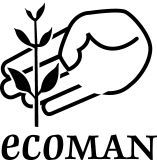 Last summer a new client had requested a garden cleanup and during the course of our conversation it came up that the tree pictured here had been a mystery to the homeowner for years. The client had gone so far as taking cuttings to the local nursery and they too were unable to identify it. After doing some research it was positively identified as Celtis occidentalis or common hackberry. According to Dirr (1975), this tree is native to North America and grows from Manitoba to Quebec and south to North Carolina, Alabama, Georgia and Oklahoma. One might wonder why a native tree with such a large range would stump local gardeners and nurseries. Although this is not always the case, many native trees are not widely cultivated, this would explain why nursery staff were unfamiliar with it. What got me was the timing of my visit in early spring gave only three clues as to the mystery tree's identity: the unusual corky bark, the fact that the flowers emerge before the leaf and the alternate arrangement of the buds (see below for what I had to go on initially). In addition its large size makes it somewhat unsuitable for the small urban downtown Toronto gardens we usually spend time in, so in 10 years of gardening I had not come across it. I have to admit a certain degree of satisfaction identifying the tree and successfully ending the mystery for a new client. Score one for Ecoman!
Last summer a new client had requested a garden cleanup and during the course of our conversation it came up that the tree pictured here had been a mystery to the homeowner for years. The client had gone so far as taking cuttings to the local nursery and they too were unable to identify it. After doing some research it was positively identified as Celtis occidentalis or common hackberry. According to Dirr (1975), this tree is native to North America and grows from Manitoba to Quebec and south to North Carolina, Alabama, Georgia and Oklahoma. One might wonder why a native tree with such a large range would stump local gardeners and nurseries. Although this is not always the case, many native trees are not widely cultivated, this would explain why nursery staff were unfamiliar with it. What got me was the timing of my visit in early spring gave only three clues as to the mystery tree's identity: the unusual corky bark, the fact that the flowers emerge before the leaf and the alternate arrangement of the buds (see below for what I had to go on initially). In addition its large size makes it somewhat unsuitable for the small urban downtown Toronto gardens we usually spend time in, so in 10 years of gardening I had not come across it. I have to admit a certain degree of satisfaction identifying the tree and successfully ending the mystery for a new client. Score one for Ecoman!Dirr, Michael A. 1975 Manual of Woody Landscape Plants. Stipes Publishing. Champaign, Illinois. Fifth Edition.






2 comments:
Is there any problem Ecoman can't solve?
Could use your help in identifying some plants here in Cambridge. When can you schedule me in?
we try. as far as plant ID goes...how about sending pictures?
Post a Comment